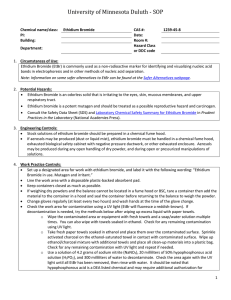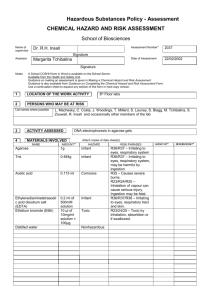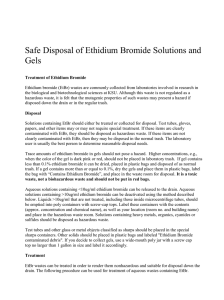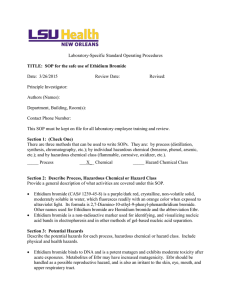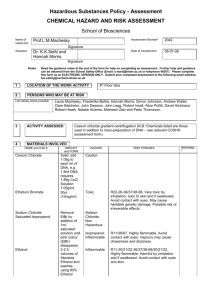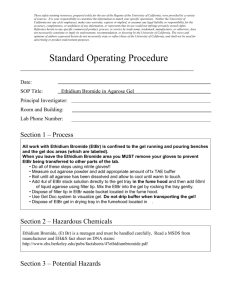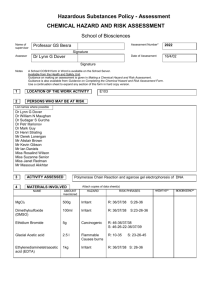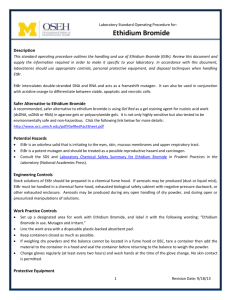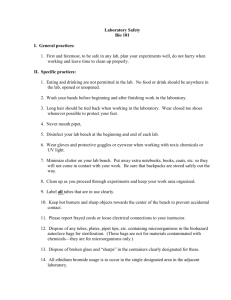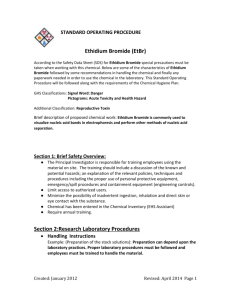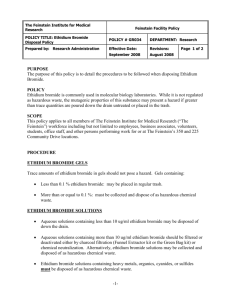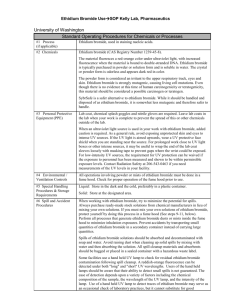Ethidium Bromide SOP - Environmental Health & Safety
advertisement
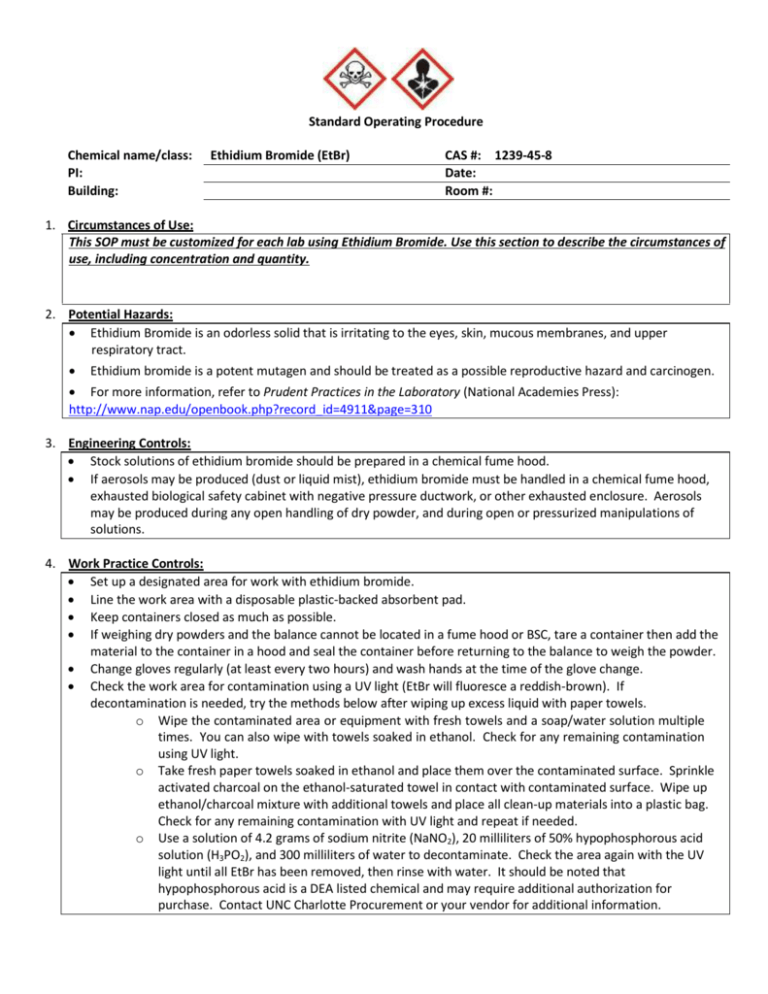
Standard Operating Procedure Chemical name/class: PI: Building: Ethidium Bromide (EtBr) CAS #: 1239-45-8 Date: Room #: 1. Circumstances of Use: This SOP must be customized for each lab using Ethidium Bromide. Use this section to describe the circumstances of use, including concentration and quantity. 2. Potential Hazards: Ethidium Bromide is an odorless solid that is irritating to the eyes, skin, mucous membranes, and upper respiratory tract. Ethidium bromide is a potent mutagen and should be treated as a possible reproductive hazard and carcinogen. For more information, refer to Prudent Practices in the Laboratory (National Academies Press): http://www.nap.edu/openbook.php?record_id=4911&page=310 3. Engineering Controls: Stock solutions of ethidium bromide should be prepared in a chemical fume hood. If aerosols may be produced (dust or liquid mist), ethidium bromide must be handled in a chemical fume hood, exhausted biological safety cabinet with negative pressure ductwork, or other exhausted enclosure. Aerosols may be produced during any open handling of dry powder, and during open or pressurized manipulations of solutions. 4. Work Practice Controls: Set up a designated area for work with ethidium bromide. Line the work area with a disposable plastic-backed absorbent pad. Keep containers closed as much as possible. If weighing dry powders and the balance cannot be located in a fume hood or BSC, tare a container then add the material to the container in a hood and seal the container before returning to the balance to weigh the powder. Change gloves regularly (at least every two hours) and wash hands at the time of the glove change. Check the work area for contamination using a UV light (EtBr will fluoresce a reddish-brown). If decontamination is needed, try the methods below after wiping up excess liquid with paper towels. o Wipe the contaminated area or equipment with fresh towels and a soap/water solution multiple times. You can also wipe with towels soaked in ethanol. Check for any remaining contamination using UV light. o Take fresh paper towels soaked in ethanol and place them over the contaminated surface. Sprinkle activated charcoal on the ethanol-saturated towel in contact with contaminated surface. Wipe up ethanol/charcoal mixture with additional towels and place all clean-up materials into a plastic bag. Check for any remaining contamination with UV light and repeat if needed. o Use a solution of 4.2 grams of sodium nitrite (NaNO2), 20 milliliters of 50% hypophosphorous acid solution (H3PO2), and 300 milliliters of water to decontaminate. Check the area again with the UV light until all EtBr has been removed, then rinse with water. It should be noted that hypophosphorous acid is a DEA listed chemical and may require additional authorization for purchase. Contact UNC Charlotte Procurement or your vendor for additional information. 5. Personal protective equipment (PPE): Standard nitrile laboratory gloves and a fully buttoned lab coat with sleeves extending to the wrists should be worn when handling EtBr (powder and solutions). If splashes may occur, wear goggles and a face shield. Otherwise, wear standard laboratory safety glasses. When using a UV light to visualize EtBr contamination, wear UV-blocking eyewear or work behind a UV shielding glass. (Most standard safety glasses will block UV, but employees should check the approval of their safety glasses.) In cases where the arms or torso may be exposed to liquid suspensions or dry particles, wear Tyvek sleeves and/or gowns (or other air-tight non-woven textile). 6. Transportation and Storage: Group VII – Non-Volatile Toxin EtBr powder and solutions should be in tightly closed shatter-resistant containers during transportation and storage. Secondary containment is advised. It should be stored away from strong oxidizing agents in a cool, dry place. 7. Waste Disposal: Handle and store ether waste following the guidelines above while accumulating wastes and awaiting chemical waste pickup. Waste must be disposed of following your laboratory-specific chemical hygiene plan and the requirements of UNC Charlotte’s Laboratory Chemical Waste Management Practices https://safety.uncc.edu/laboratory-and-research-safety/hazardous-universal-waste. UNC-Charlotte will provide labs that produce Ethidium Bromide gels with a 5 gallon waste bucket. 8. Exposures/Unintended contact: Flush exposed eyes or skin with water for at least 15 minutes, then seek medical attention if needed. If inhaled, remove victim from the contaminated area, then seek medical attention. Call 911 from a campus phone or 687-2200 from any phone to request assistance if needed. Contact the Student Health Center at 704-687-7400 for medical advice on occupational chemical exposures. For an actual chemical exposure, complete the work-related injury or illness report found at: http://safety.uncc.edu/workers-compensation/workers-compensation-section 9. Spill Procedure: For spills of liquid suspensions, absorb the spilled material with paper towels or other absorbent, then decontaminate the area following one of the procedures outlined in the Work Practices section. Place all absorbent and PPE into a bag and seal. For small spills of powdered or granular EtBr, carefully wipe up with wet paper towels, then follow one of the decontamination procedures outlined in the Work Practices Section. Place any clean-up materials and PPE into a bag and seal. Medium to large spills of powdered EtBr outside of a chemical fume hood or other enclosure should be referred to Campus Police by calling 911 from a campus phone or 704-687-2200 from any phone. 10. Training of personnel: All personnel are required to complete the UNC Charlotte EHS Laboratory Environment Training Checklist. This checklist includes an introduction to general chemical safety as well as review of the laboratory specific safety plan. Furthermore, all personnel shall read and fully adhere to this SOP when handling the chemical. “I have read and understand this SOP. I agree to fully adhere to its requirements.” Last First UNC Charlotte ID Signature
